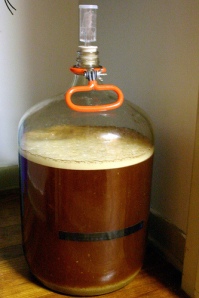Take a sneak peak into Gordon’s program of how he found some families that make homemade beer!
Really interesting!
Enjoy!
Take a sneak peak into Gordon’s program of how he found some families that make homemade beer!
Really interesting!
Enjoy!
The few items you need to brew your own homemade beer can be found at your nearest beermaking supply shop, or at most hardware stores.
– One 10-gallon «food grade» plastic pail with lid. Cost: about $12.00
– Siphon hose. You’ll need a 74″ length of 5/16″ «food grade» vinyl tubing. Cost: $2.00
– Hose clamp for siphon. Cost: $1.00
– Twelve 2- liter plastic pop bottles, with lids. – Hydrometer. Cost: $8.00. A thermometer is also useful.
– Large pot, or turkey roaster.
High Quality Ingredients
Malt Extract. One 40oz. can of any flavor you like ( light, dark, stout), we prefer light. The 1.5kg can contains more malt extract so you can make a larger batch or use the same method here to make a richer beer. You can also buy ‘pre-hopped’ extract which will impart more of a hop flavor to your beer.
– Yeast. 1 tsp brewers’ yeast. Note: some malt comes with little packets of yeast included.
– Sugar. 6 – 7 cups of regular white sugar, or 8 – 9 cups of corn sugar (preferred).
For even better results, consider using two cans of the malt extract and not using any SUGAR!!!!!!!! This adds to the expense, but further enriches the taste of the beer.
First of all, what is brewing?
The production of beer through steeping stapled foods such as potatoes, wheats, corn and rice in water and then fermenting with yeast, that’s Brewing. The interesting fact about homemade beer is that you make small scales of beer as a hobby for personal or group consumption, in a cheaper and wider range of ingredients.
Did you know that… For beer, the brewing process is very similar to the commercial brewing but the difference is that the creators can choose high quality ingredients and also choose between high quality ingredients used in wide range of ingredients used in commercialization. The basic ingredients that are necessary in homemade brewing include water, malt, hops and yeast; in addition, they can add herbal ingredients to give them an extra scent.

Homemade beer
But beer is no the only thing that can bee homemade brewed. Cider, ginger, chicha, pulque and tepache can also be brewed but with another ingredients and containing high amount of yeast and sugar.
People in the northern part of Mexico, like to do their own beer because it’s cheaper and it’s different from the local brands. Adjusting the recipe to its palate is a pleasure that not everyone can taste. Home brewing can reduce environmental impact of fermented beverages by using less bottle packaging and less local transportation that can reduce pollution.
The Javilive diary about his work, lifestyle and hobbies
Diseño, publicidad, creatividad y marketing
Sobre Sostenibilidad, Innovación y Medio Ambiente
Branded Content, Engagement, Marketing Online, Social Media
Social Media for all
Branding & Marketing Estratégico
El hombre era nómada antes que agricultor. Siendo agricultor sabía que había algo detrás de esas montañas. Y se hizo viajero. Y conoció mundo. Y volvió a casa y lo celebraron con cerveza. Y les contó su viaje. Pero un imbécil en la tribu no le creía, e inventó la cámara fotográfica. Este blog está relacionado con el cuento: viajes, comer, beber, emprender, relatos, surf y fotografía. Porque ¿de que te sirve viajar al lugar más bonito del mundo si no tienes una foto para callar la boca a ese imbécil?
Advertising. Social Media. Publicaciones. Humor. Tecnología. HR Communications. Laboratorio de teorías. News clipping.
el blog de Ricardo Buchó
be. Intelligent Multimedia Education
Estrategia de presencia online: de cómo sacar provecho de la Comunicación 2.0
Blog sobre Social Media, Marketing Digital, Comunicación Corporativa y Publicidad
Comentarios recientes